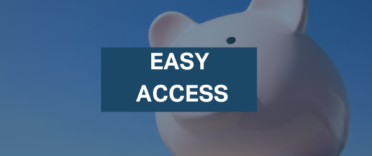
This type of account allows you to access your funds at all times and you don't need to lock your money away for a set period of time in order to earn interest. In this article we look at how instant access savings accounts work and whether they're right for you.
How does an instant access savings account work?
An instant access savings account is designed to help you build your savings flexibly. Instant access savings accounts typically come with features like:
- Low minimum deposits
- The ability to withdraw money instantly
- Fewer (or no) withdrawal limits
Usually, interest rates on instant access savings accounts are variable. This means the interest rate on your savings can go up or down at any time. So, while you'll always "earn" some form of interest on your account when interest rates fall, the growth might not always be inflation-beating. However, instant access savings accounts have their perks.
For example, if you opt for a fixed-rate bond or notice account, you'll usually have less flexibility. You typically lock your money away for a set period of time and usually can't access those funds if an emergency arises. In some cases, you can't withdraw your money at all, and in other cases, you can't do so without losing specific perks or a favourable interest rate. Also, when interest rates are on the rise, a variable interest savings account can be a great way to maximise our savings as you're not locked into a potentially lower rate.
In many ways, instant access savings accounts can be the best of both worlds; you get to earn interest on your money while also being able to access the funds as and when needed. However, there might be tax implications to consider.
Do you pay tax on savings held in an instant access savings account?
As with any type of savings account, you might need to pay tax on your savings if you go over your personal savings allowance. This allowance varies depending on whether you're a basic rate taxpayer, a higher rate tax payer, or an additional rate taxpayer. Taxation rules can be complicated, and the exact amount you'll pay varies depending on your earnings and personal circumstances.
As a rule of thumb, in the 2024/2025 tax year, basic rate taxpayers can earn up to £1,000 in interest, tax-free every year. Higher-rate taxpayers get a lower allowance of £500, and additional rate taxpayers don't get an allowance. Anything above these amounts is taxed at 20% or 40%, respectively.
So, while instant access accounts can be a great way to boost your savings, you may need to pay tax on the interest you receive. If you're interested in saving without paying tax, you can look into Cash ISA options, which can range from instant access to fixed-rate ISAs. You can put up to £20,000 in an ISA each year tax-free, and you won't have to pay tax on the interest. You can find out more about the best easy access cash ISAs on the market right now here.
What is the difference between an instant access and easy access savings account?
Instant access and easy access savings accounts both offer flexibility when it comes to accessing your funds. However, easy access savings accounts are typically less flexible. While with an instant access account, you can withdraw your money at any time without incurring penalties, an easy access account may come with certain restrictions and limitations. These can include:
- A limit on the number of withdrawals
- Higher minimum deposits
- Potential penalties for going over the limit (but this is rare)
While you can still access your funds whenever you want with an easy-access account, there may be a limit on how many withdrawals you can make each year before you lose out on a promotional interest rate, for example.
Easy-access savings accounts sometimes offer higher interest rates compared to instant-access savings accounts, which is why some people may prefer this option. It's a trade-off that can work well. You may lose some of the flexibility an instant access account offers for the benefit of a higher interest rate. This type of account could work well for savers who want easy access to their money and aren't willing to lock their funds away for months or years.
How to open an instant access savings account
Opening an instant-access savings account is generally straightforward. Depending on the account you've chosen, you can do so in branch, online, or over the phone. There may be a minimum deposit required to get you set up. But, as instant access savings accounts are designed to be flexible, this can be as low as £1.
Sometimes, you might need to have a current account with the bank before you can access their savings account. Once you're set up, it's often as simple as applying via your banking app. You could have your online savings account up and running in just a few minutes.
How safe are your savings in an instant access savings account
Instant access savings accounts can be a good option for risk-averse savers who want a guaranteed return based on a variable interest rate.
Your deposits are also typically protected by the Financial Services Compensation Scheme (FSCS) if you open an account with a licensed bank or building society. The FSCS protects your deposits up to £85,000 per person per bank. (Joint savings accounts are protected up to £170,000). It is important to note that the FSCS limit applies per authorised firm and so certain banks and building societies may share a banking license. A good example is HSBC and First Direct; those who bank with both would be covered up to £85,000 across both providers.
Which is the best instant access savings account?
There are lots of instant access savings accounts to choose from. Rates are constantly changing, and the best deal today may differ from the next. While the interest rate is likely to be a driving factor in your decision, there are some other factors to consider before choosing an account. These include:
- The minimum deposit required to open an account
- The minimum and maximum amount you can deposit each month
- Whether interest is paid out daily, monthly, or annually
- Whether you can manage the account online or via an app
- Whether there are any restrictions and limits on how often you can withdraw money (only applies to easy access savings accounts)
Some accounts with higher interest rates may limit how much you can deposit each month. Others may offer higher rates on higher balances. The right account for you will depend on how much you want to save.
It's also worth keeping in mind that some bank accounts come with a bonus interest rate to entice new customers. This higher interest rate usually lasts for a set period, after which the account reverts to a lower interest rate. In some cases, the bonus rate comes with conditions and restrictions. For instance, you may get a higher rate for a particular month if you don't make withdrawals during that month.
If you want to compare savings accounts, check out our best buy tables which are regularly updated as rates change.




